Partnership Working: Outcomes in Health and Social Care Report
VerifiedAdded on 2019/12/03
|12
|3885
|33
Report
AI Summary
This report delves into the multifaceted aspects of partnership working within the health and social care sectors. It begins by exploring the core philosophies underpinning effective collaboration, such as effective communication, power-sharing, and trust. The report then evaluates various partnership relationships, including those involving service users, professional groups, and organizations. It further examines different models of partnership working, emphasizing confidentiality and coordinated care. Relevant legislation, such as the Equality Act 2010 and the Children Act 2004, are discussed, highlighting their impact on collaborative practices. The report also analyzes how differences in working practices and policies can affect collaboration, focusing on legal obligations, record management, and confidentiality. Finally, it evaluates the positive outcomes of partnership working for service users, professionals, and organizations, while also identifying potential barriers and strategies for improvement.

Working in Partnership
Paraphrase This Document
Need a fresh take? Get an instant paraphrase of this document with our AI Paraphraser
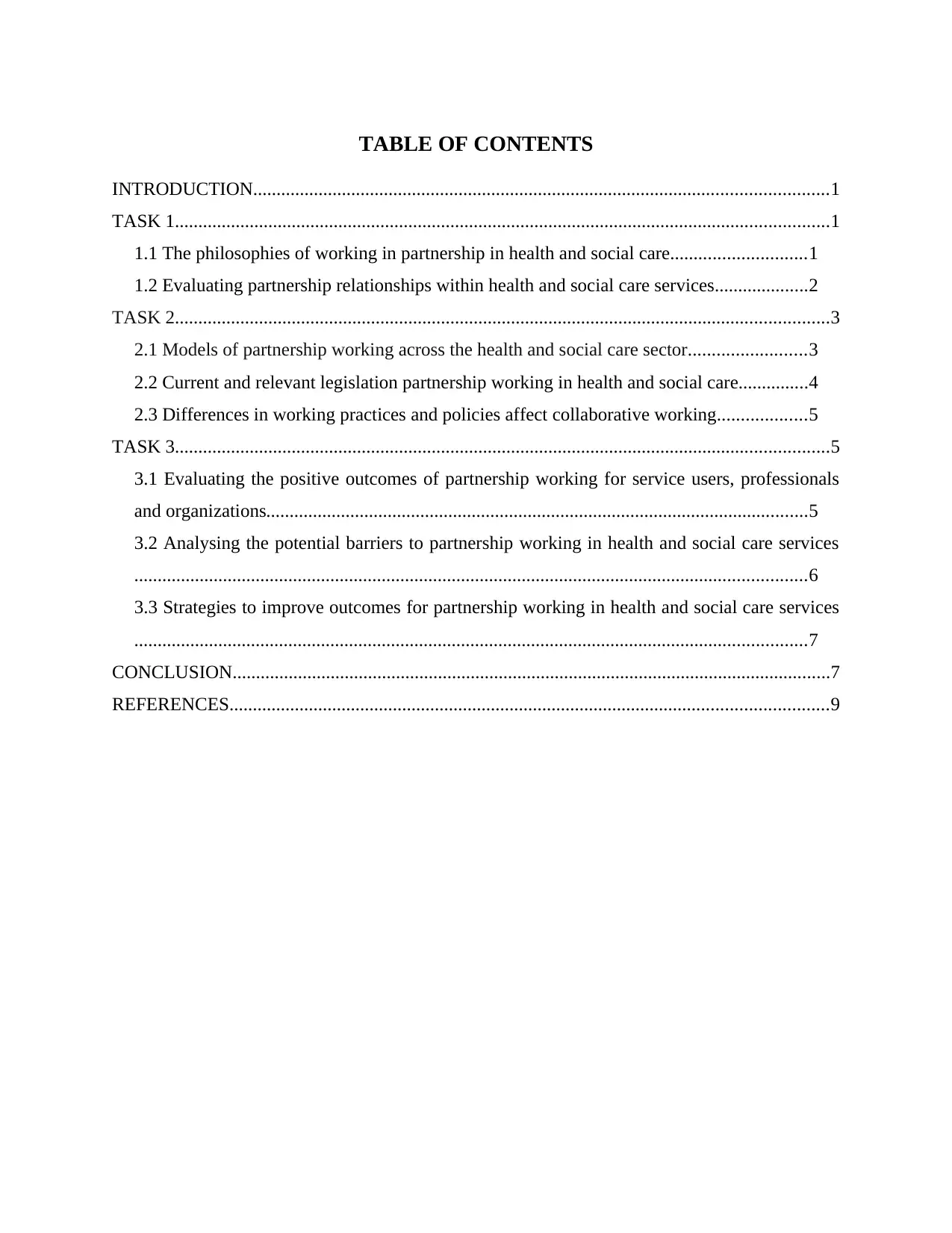
TABLE OF CONTENTS
INTRODUCTION...........................................................................................................................1
TASK 1............................................................................................................................................1
1.1 The philosophies of working in partnership in health and social care.............................1
1.2 Evaluating partnership relationships within health and social care services....................2
TASK 2............................................................................................................................................3
2.1 Models of partnership working across the health and social care sector.........................3
2.2 Current and relevant legislation partnership working in health and social care...............4
2.3 Differences in working practices and policies affect collaborative working...................5
TASK 3............................................................................................................................................5
3.1 Evaluating the positive outcomes of partnership working for service users, professionals
and organizations....................................................................................................................5
3.2 Analysing the potential barriers to partnership working in health and social care services
................................................................................................................................................6
3.3 Strategies to improve outcomes for partnership working in health and social care services
................................................................................................................................................7
CONCLUSION................................................................................................................................7
REFERENCES................................................................................................................................9
INTRODUCTION...........................................................................................................................1
TASK 1............................................................................................................................................1
1.1 The philosophies of working in partnership in health and social care.............................1
1.2 Evaluating partnership relationships within health and social care services....................2
TASK 2............................................................................................................................................3
2.1 Models of partnership working across the health and social care sector.........................3
2.2 Current and relevant legislation partnership working in health and social care...............4
2.3 Differences in working practices and policies affect collaborative working...................5
TASK 3............................................................................................................................................5
3.1 Evaluating the positive outcomes of partnership working for service users, professionals
and organizations....................................................................................................................5
3.2 Analysing the potential barriers to partnership working in health and social care services
................................................................................................................................................6
3.3 Strategies to improve outcomes for partnership working in health and social care services
................................................................................................................................................7
CONCLUSION................................................................................................................................7
REFERENCES................................................................................................................................9
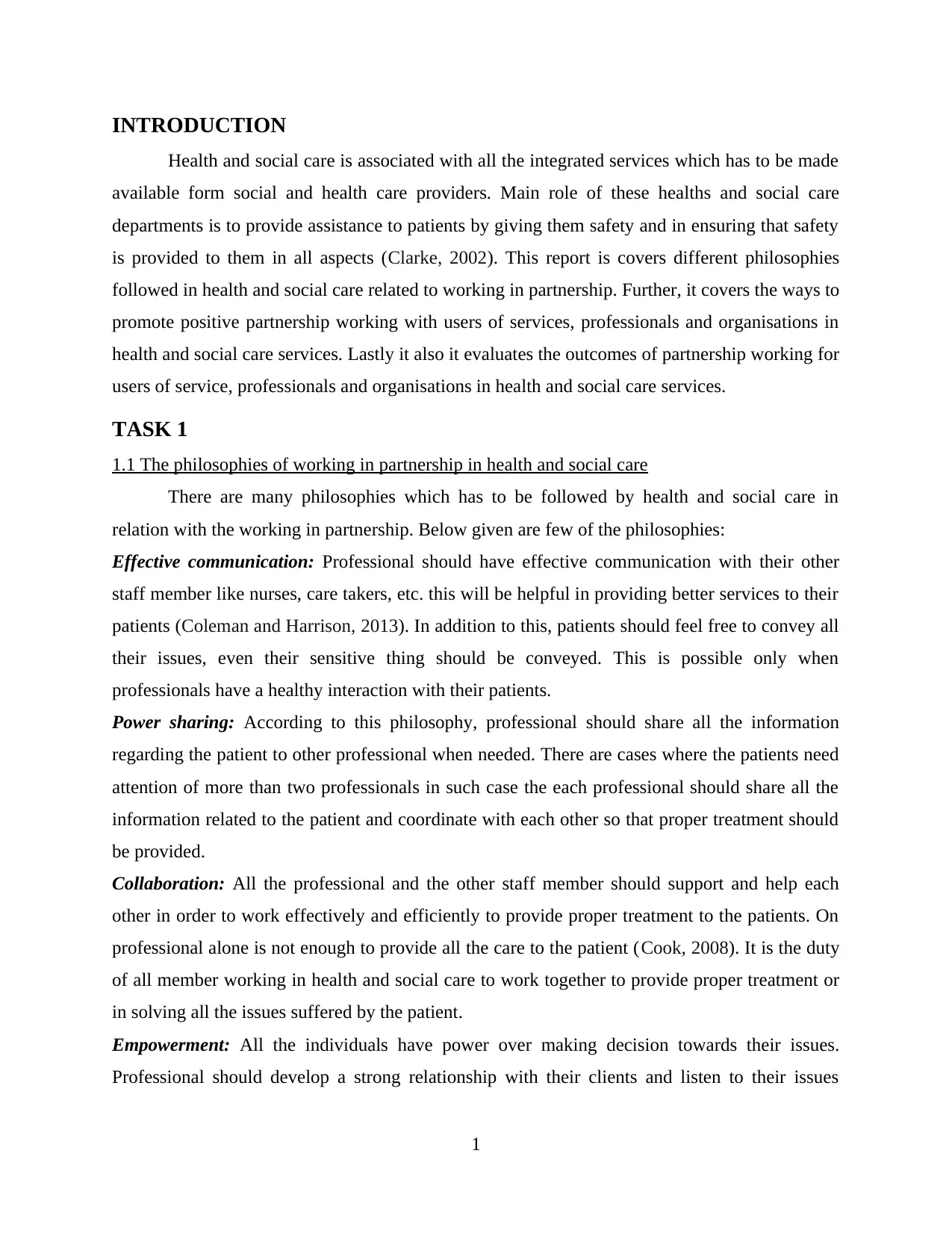
INTRODUCTION
Health and social care is associated with all the integrated services which has to be made
available form social and health care providers. Main role of these healths and social care
departments is to provide assistance to patients by giving them safety and in ensuring that safety
is provided to them in all aspects (Clarke, 2002). This report is covers different philosophies
followed in health and social care related to working in partnership. Further, it covers the ways to
promote positive partnership working with users of services, professionals and organisations in
health and social care services. Lastly it also it evaluates the outcomes of partnership working for
users of service, professionals and organisations in health and social care services.
TASK 1
1.1 The philosophies of working in partnership in health and social care
There are many philosophies which has to be followed by health and social care in
relation with the working in partnership. Below given are few of the philosophies:
Effective communication: Professional should have effective communication with their other
staff member like nurses, care takers, etc. this will be helpful in providing better services to their
patients (Coleman and Harrison, 2013). In addition to this, patients should feel free to convey all
their issues, even their sensitive thing should be conveyed. This is possible only when
professionals have a healthy interaction with their patients.
Power sharing: According to this philosophy, professional should share all the information
regarding the patient to other professional when needed. There are cases where the patients need
attention of more than two professionals in such case the each professional should share all the
information related to the patient and coordinate with each other so that proper treatment should
be provided.
Collaboration: All the professional and the other staff member should support and help each
other in order to work effectively and efficiently to provide proper treatment to the patients. On
professional alone is not enough to provide all the care to the patient (Cook, 2008). It is the duty
of all member working in health and social care to work together to provide proper treatment or
in solving all the issues suffered by the patient.
Empowerment: All the individuals have power over making decision towards their issues.
Professional should develop a strong relationship with their clients and listen to their issues
1
Health and social care is associated with all the integrated services which has to be made
available form social and health care providers. Main role of these healths and social care
departments is to provide assistance to patients by giving them safety and in ensuring that safety
is provided to them in all aspects (Clarke, 2002). This report is covers different philosophies
followed in health and social care related to working in partnership. Further, it covers the ways to
promote positive partnership working with users of services, professionals and organisations in
health and social care services. Lastly it also it evaluates the outcomes of partnership working for
users of service, professionals and organisations in health and social care services.
TASK 1
1.1 The philosophies of working in partnership in health and social care
There are many philosophies which has to be followed by health and social care in
relation with the working in partnership. Below given are few of the philosophies:
Effective communication: Professional should have effective communication with their other
staff member like nurses, care takers, etc. this will be helpful in providing better services to their
patients (Coleman and Harrison, 2013). In addition to this, patients should feel free to convey all
their issues, even their sensitive thing should be conveyed. This is possible only when
professionals have a healthy interaction with their patients.
Power sharing: According to this philosophy, professional should share all the information
regarding the patient to other professional when needed. There are cases where the patients need
attention of more than two professionals in such case the each professional should share all the
information related to the patient and coordinate with each other so that proper treatment should
be provided.
Collaboration: All the professional and the other staff member should support and help each
other in order to work effectively and efficiently to provide proper treatment to the patients. On
professional alone is not enough to provide all the care to the patient (Cook, 2008). It is the duty
of all member working in health and social care to work together to provide proper treatment or
in solving all the issues suffered by the patient.
Empowerment: All the individuals have power over making decision towards their issues.
Professional should develop a strong relationship with their clients and listen to their issues
1
⊘ This is a preview!⊘
Do you want full access?
Subscribe today to unlock all pages.

Trusted by 1+ million students worldwide
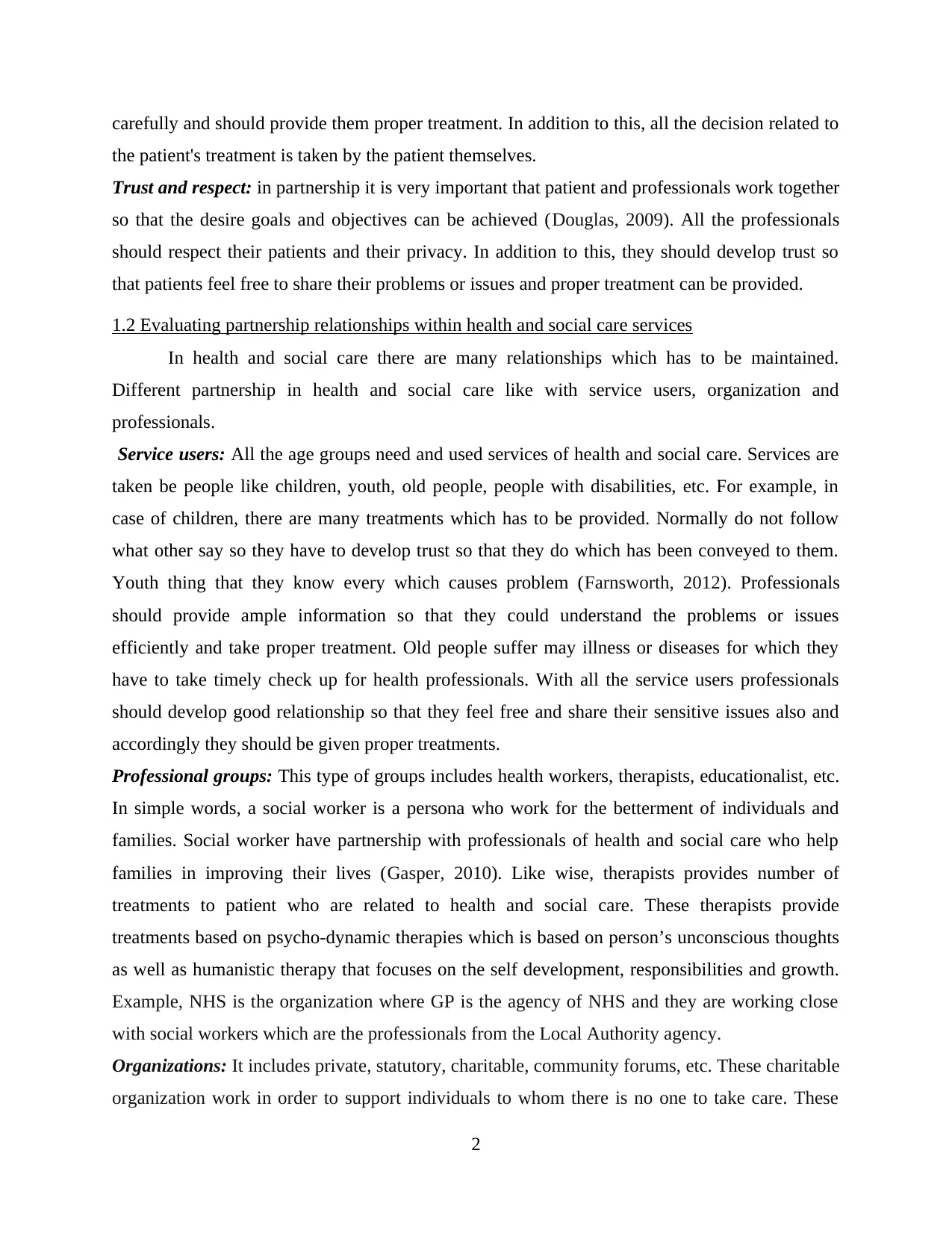
carefully and should provide them proper treatment. In addition to this, all the decision related to
the patient's treatment is taken by the patient themselves.
Trust and respect: in partnership it is very important that patient and professionals work together
so that the desire goals and objectives can be achieved (Douglas, 2009). All the professionals
should respect their patients and their privacy. In addition to this, they should develop trust so
that patients feel free to share their problems or issues and proper treatment can be provided.
1.2 Evaluating partnership relationships within health and social care services
In health and social care there are many relationships which has to be maintained.
Different partnership in health and social care like with service users, organization and
professionals.
Service users: All the age groups need and used services of health and social care. Services are
taken be people like children, youth, old people, people with disabilities, etc. For example, in
case of children, there are many treatments which has to be provided. Normally do not follow
what other say so they have to develop trust so that they do which has been conveyed to them.
Youth thing that they know every which causes problem (Farnsworth, 2012). Professionals
should provide ample information so that they could understand the problems or issues
efficiently and take proper treatment. Old people suffer may illness or diseases for which they
have to take timely check up for health professionals. With all the service users professionals
should develop good relationship so that they feel free and share their sensitive issues also and
accordingly they should be given proper treatments.
Professional groups: This type of groups includes health workers, therapists, educationalist, etc.
In simple words, a social worker is a persona who work for the betterment of individuals and
families. Social worker have partnership with professionals of health and social care who help
families in improving their lives (Gasper, 2010). Like wise, therapists provides number of
treatments to patient who are related to health and social care. These therapists provide
treatments based on psycho-dynamic therapies which is based on person’s unconscious thoughts
as well as humanistic therapy that focuses on the self development, responsibilities and growth.
Example, NHS is the organization where GP is the agency of NHS and they are working close
with social workers which are the professionals from the Local Authority agency.
Organizations: It includes private, statutory, charitable, community forums, etc. These charitable
organization work in order to support individuals to whom there is no one to take care. These
2
the patient's treatment is taken by the patient themselves.
Trust and respect: in partnership it is very important that patient and professionals work together
so that the desire goals and objectives can be achieved (Douglas, 2009). All the professionals
should respect their patients and their privacy. In addition to this, they should develop trust so
that patients feel free to share their problems or issues and proper treatment can be provided.
1.2 Evaluating partnership relationships within health and social care services
In health and social care there are many relationships which has to be maintained.
Different partnership in health and social care like with service users, organization and
professionals.
Service users: All the age groups need and used services of health and social care. Services are
taken be people like children, youth, old people, people with disabilities, etc. For example, in
case of children, there are many treatments which has to be provided. Normally do not follow
what other say so they have to develop trust so that they do which has been conveyed to them.
Youth thing that they know every which causes problem (Farnsworth, 2012). Professionals
should provide ample information so that they could understand the problems or issues
efficiently and take proper treatment. Old people suffer may illness or diseases for which they
have to take timely check up for health professionals. With all the service users professionals
should develop good relationship so that they feel free and share their sensitive issues also and
accordingly they should be given proper treatments.
Professional groups: This type of groups includes health workers, therapists, educationalist, etc.
In simple words, a social worker is a persona who work for the betterment of individuals and
families. Social worker have partnership with professionals of health and social care who help
families in improving their lives (Gasper, 2010). Like wise, therapists provides number of
treatments to patient who are related to health and social care. These therapists provide
treatments based on psycho-dynamic therapies which is based on person’s unconscious thoughts
as well as humanistic therapy that focuses on the self development, responsibilities and growth.
Example, NHS is the organization where GP is the agency of NHS and they are working close
with social workers which are the professionals from the Local Authority agency.
Organizations: It includes private, statutory, charitable, community forums, etc. These charitable
organization work in order to support individuals to whom there is no one to take care. These
2
Paraphrase This Document
Need a fresh take? Get an instant paraphrase of this document with our AI Paraphraser
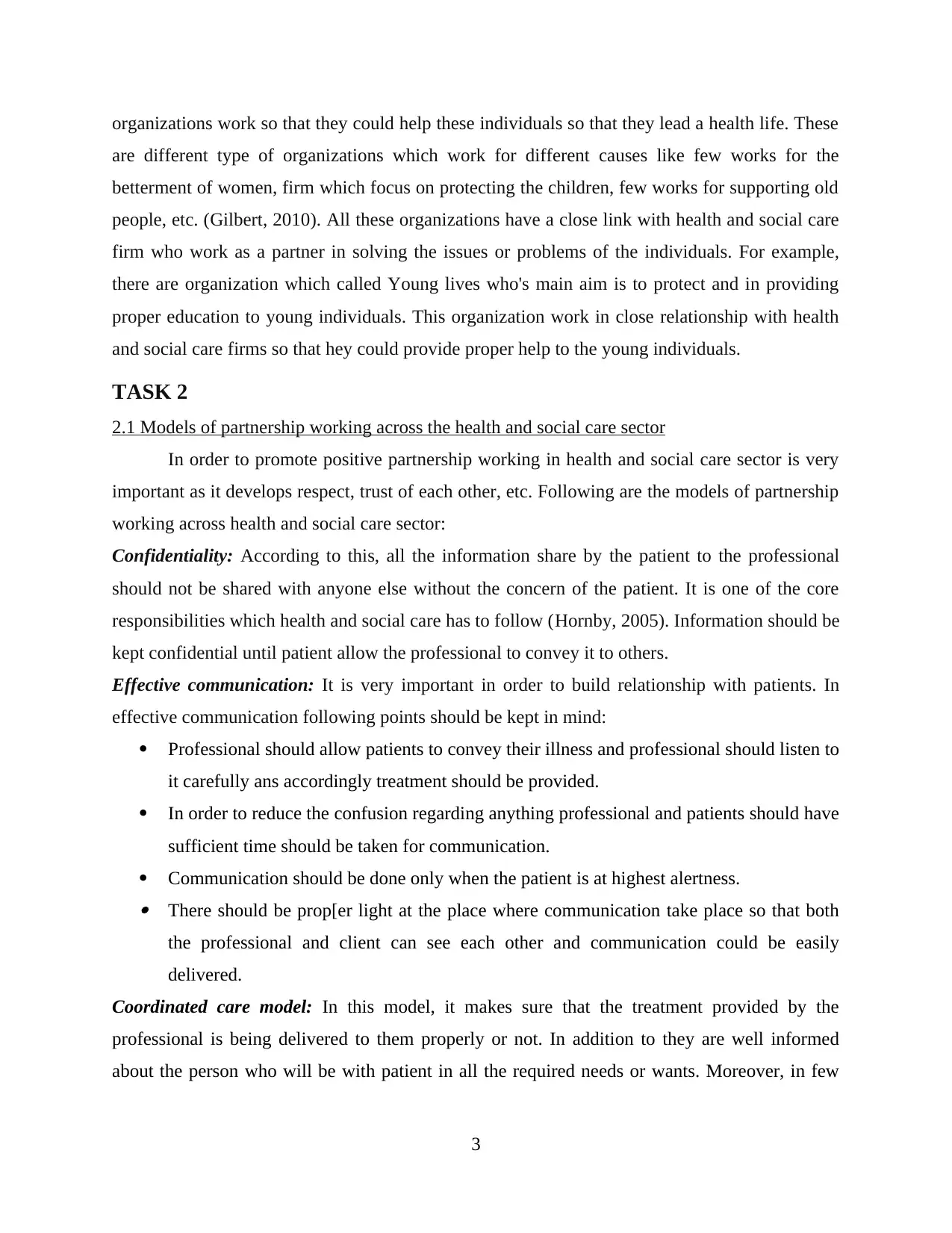
organizations work so that they could help these individuals so that they lead a health life. These
are different type of organizations which work for different causes like few works for the
betterment of women, firm which focus on protecting the children, few works for supporting old
people, etc. (Gilbert, 2010). All these organizations have a close link with health and social care
firm who work as a partner in solving the issues or problems of the individuals. For example,
there are organization which called Young lives who's main aim is to protect and in providing
proper education to young individuals. This organization work in close relationship with health
and social care firms so that hey could provide proper help to the young individuals.
TASK 2
2.1 Models of partnership working across the health and social care sector
In order to promote positive partnership working in health and social care sector is very
important as it develops respect, trust of each other, etc. Following are the models of partnership
working across health and social care sector:
Confidentiality: According to this, all the information share by the patient to the professional
should not be shared with anyone else without the concern of the patient. It is one of the core
responsibilities which health and social care has to follow (Hornby, 2005). Information should be
kept confidential until patient allow the professional to convey it to others.
Effective communication: It is very important in order to build relationship with patients. In
effective communication following points should be kept in mind:
Professional should allow patients to convey their illness and professional should listen to
it carefully ans accordingly treatment should be provided.
In order to reduce the confusion regarding anything professional and patients should have
sufficient time should be taken for communication.
Communication should be done only when the patient is at highest alertness. There should be prop[er light at the place where communication take place so that both
the professional and client can see each other and communication could be easily
delivered.
Coordinated care model: In this model, it makes sure that the treatment provided by the
professional is being delivered to them properly or not. In addition to they are well informed
about the person who will be with patient in all the required needs or wants. Moreover, in few
3
are different type of organizations which work for different causes like few works for the
betterment of women, firm which focus on protecting the children, few works for supporting old
people, etc. (Gilbert, 2010). All these organizations have a close link with health and social care
firm who work as a partner in solving the issues or problems of the individuals. For example,
there are organization which called Young lives who's main aim is to protect and in providing
proper education to young individuals. This organization work in close relationship with health
and social care firms so that hey could provide proper help to the young individuals.
TASK 2
2.1 Models of partnership working across the health and social care sector
In order to promote positive partnership working in health and social care sector is very
important as it develops respect, trust of each other, etc. Following are the models of partnership
working across health and social care sector:
Confidentiality: According to this, all the information share by the patient to the professional
should not be shared with anyone else without the concern of the patient. It is one of the core
responsibilities which health and social care has to follow (Hornby, 2005). Information should be
kept confidential until patient allow the professional to convey it to others.
Effective communication: It is very important in order to build relationship with patients. In
effective communication following points should be kept in mind:
Professional should allow patients to convey their illness and professional should listen to
it carefully ans accordingly treatment should be provided.
In order to reduce the confusion regarding anything professional and patients should have
sufficient time should be taken for communication.
Communication should be done only when the patient is at highest alertness. There should be prop[er light at the place where communication take place so that both
the professional and client can see each other and communication could be easily
delivered.
Coordinated care model: In this model, it makes sure that the treatment provided by the
professional is being delivered to them properly or not. In addition to they are well informed
about the person who will be with patient in all the required needs or wants. Moreover, in few
3
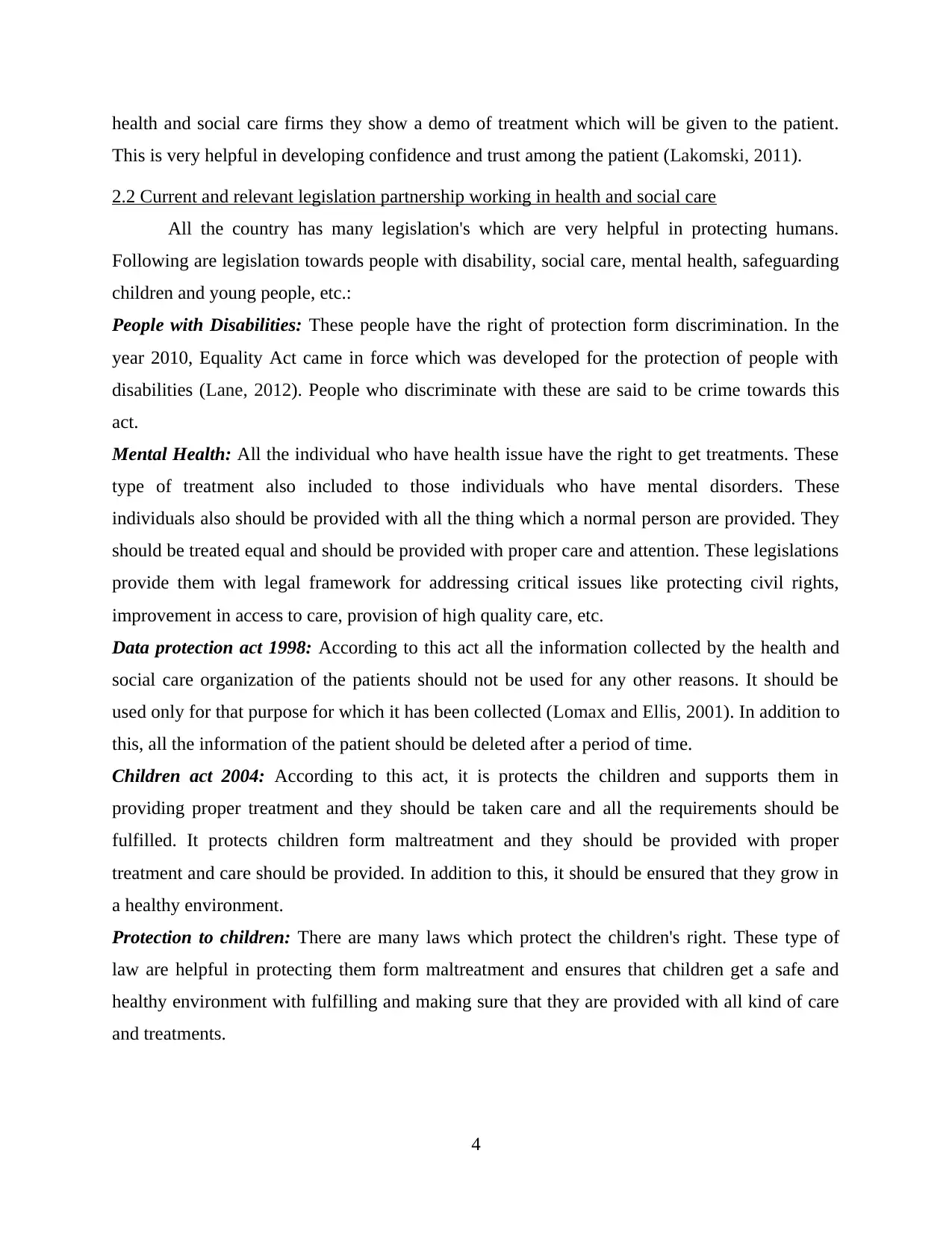
health and social care firms they show a demo of treatment which will be given to the patient.
This is very helpful in developing confidence and trust among the patient (Lakomski, 2011).
2.2 Current and relevant legislation partnership working in health and social care
All the country has many legislation's which are very helpful in protecting humans.
Following are legislation towards people with disability, social care, mental health, safeguarding
children and young people, etc.:
People with Disabilities: These people have the right of protection form discrimination. In the
year 2010, Equality Act came in force which was developed for the protection of people with
disabilities (Lane, 2012). People who discriminate with these are said to be crime towards this
act.
Mental Health: All the individual who have health issue have the right to get treatments. These
type of treatment also included to those individuals who have mental disorders. These
individuals also should be provided with all the thing which a normal person are provided. They
should be treated equal and should be provided with proper care and attention. These legislations
provide them with legal framework for addressing critical issues like protecting civil rights,
improvement in access to care, provision of high quality care, etc.
Data protection act 1998: According to this act all the information collected by the health and
social care organization of the patients should not be used for any other reasons. It should be
used only for that purpose for which it has been collected (Lomax and Ellis, 2001). In addition to
this, all the information of the patient should be deleted after a period of time.
Children act 2004: According to this act, it is protects the children and supports them in
providing proper treatment and they should be taken care and all the requirements should be
fulfilled. It protects children form maltreatment and they should be provided with proper
treatment and care should be provided. In addition to this, it should be ensured that they grow in
a healthy environment.
Protection to children: There are many laws which protect the children's right. These type of
law are helpful in protecting them form maltreatment and ensures that children get a safe and
healthy environment with fulfilling and making sure that they are provided with all kind of care
and treatments.
4
This is very helpful in developing confidence and trust among the patient (Lakomski, 2011).
2.2 Current and relevant legislation partnership working in health and social care
All the country has many legislation's which are very helpful in protecting humans.
Following are legislation towards people with disability, social care, mental health, safeguarding
children and young people, etc.:
People with Disabilities: These people have the right of protection form discrimination. In the
year 2010, Equality Act came in force which was developed for the protection of people with
disabilities (Lane, 2012). People who discriminate with these are said to be crime towards this
act.
Mental Health: All the individual who have health issue have the right to get treatments. These
type of treatment also included to those individuals who have mental disorders. These
individuals also should be provided with all the thing which a normal person are provided. They
should be treated equal and should be provided with proper care and attention. These legislations
provide them with legal framework for addressing critical issues like protecting civil rights,
improvement in access to care, provision of high quality care, etc.
Data protection act 1998: According to this act all the information collected by the health and
social care organization of the patients should not be used for any other reasons. It should be
used only for that purpose for which it has been collected (Lomax and Ellis, 2001). In addition to
this, all the information of the patient should be deleted after a period of time.
Children act 2004: According to this act, it is protects the children and supports them in
providing proper treatment and they should be taken care and all the requirements should be
fulfilled. It protects children form maltreatment and they should be provided with proper
treatment and care should be provided. In addition to this, it should be ensured that they grow in
a healthy environment.
Protection to children: There are many laws which protect the children's right. These type of
law are helpful in protecting them form maltreatment and ensures that children get a safe and
healthy environment with fulfilling and making sure that they are provided with all kind of care
and treatments.
4
⊘ This is a preview!⊘
Do you want full access?
Subscribe today to unlock all pages.

Trusted by 1+ million students worldwide
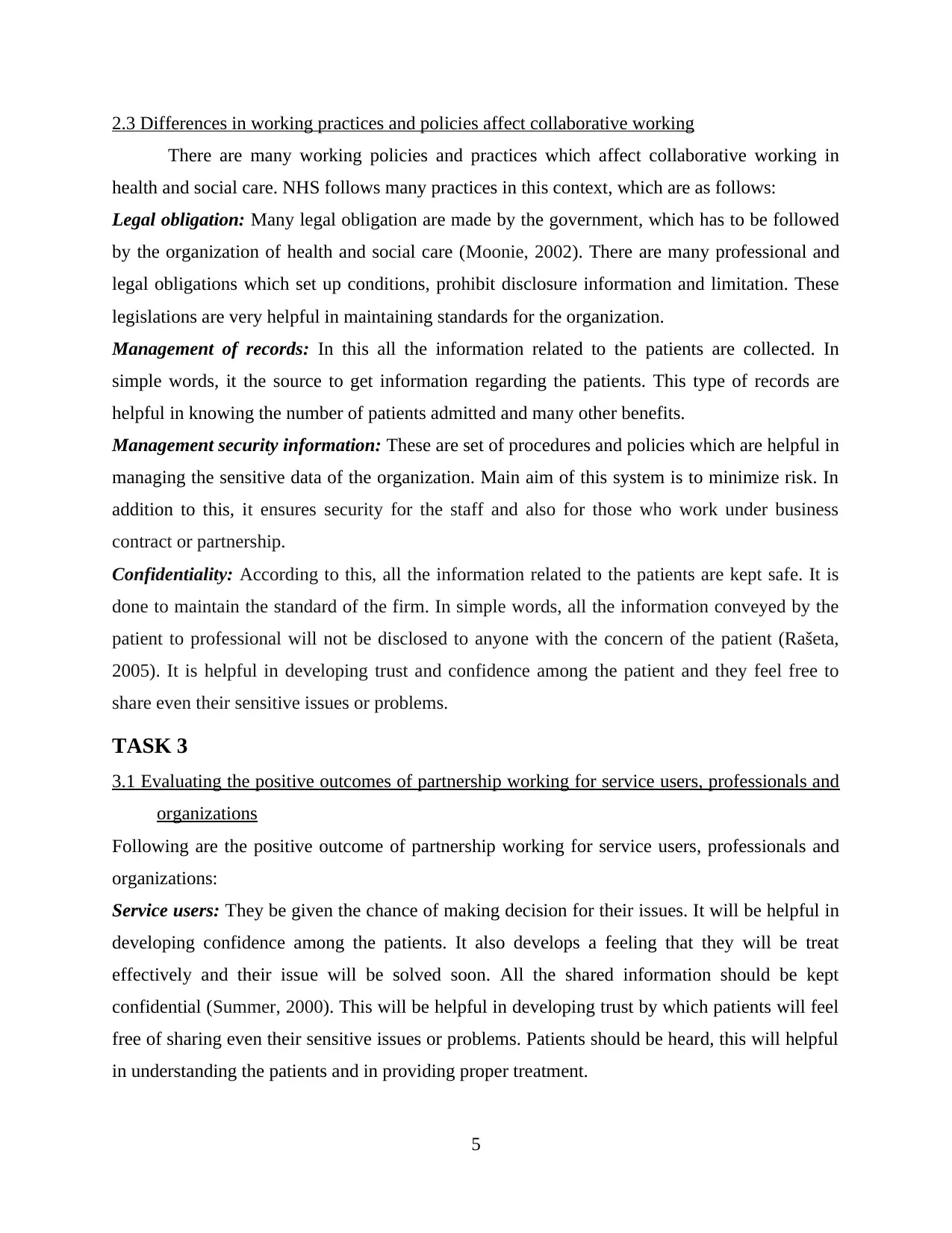
2.3 Differences in working practices and policies affect collaborative working
There are many working policies and practices which affect collaborative working in
health and social care. NHS follows many practices in this context, which are as follows:
Legal obligation: Many legal obligation are made by the government, which has to be followed
by the organization of health and social care (Moonie, 2002). There are many professional and
legal obligations which set up conditions, prohibit disclosure information and limitation. These
legislations are very helpful in maintaining standards for the organization.
Management of records: In this all the information related to the patients are collected. In
simple words, it the source to get information regarding the patients. This type of records are
helpful in knowing the number of patients admitted and many other benefits.
Management security information: These are set of procedures and policies which are helpful in
managing the sensitive data of the organization. Main aim of this system is to minimize risk. In
addition to this, it ensures security for the staff and also for those who work under business
contract or partnership.
Confidentiality: According to this, all the information related to the patients are kept safe. It is
done to maintain the standard of the firm. In simple words, all the information conveyed by the
patient to professional will not be disclosed to anyone with the concern of the patient (Rašeta,
2005). It is helpful in developing trust and confidence among the patient and they feel free to
share even their sensitive issues or problems.
TASK 3
3.1 Evaluating the positive outcomes of partnership working for service users, professionals and
organizations
Following are the positive outcome of partnership working for service users, professionals and
organizations:
Service users: They be given the chance of making decision for their issues. It will be helpful in
developing confidence among the patients. It also develops a feeling that they will be treat
effectively and their issue will be solved soon. All the shared information should be kept
confidential (Summer, 2000). This will be helpful in developing trust by which patients will feel
free of sharing even their sensitive issues or problems. Patients should be heard, this will helpful
in understanding the patients and in providing proper treatment.
5
There are many working policies and practices which affect collaborative working in
health and social care. NHS follows many practices in this context, which are as follows:
Legal obligation: Many legal obligation are made by the government, which has to be followed
by the organization of health and social care (Moonie, 2002). There are many professional and
legal obligations which set up conditions, prohibit disclosure information and limitation. These
legislations are very helpful in maintaining standards for the organization.
Management of records: In this all the information related to the patients are collected. In
simple words, it the source to get information regarding the patients. This type of records are
helpful in knowing the number of patients admitted and many other benefits.
Management security information: These are set of procedures and policies which are helpful in
managing the sensitive data of the organization. Main aim of this system is to minimize risk. In
addition to this, it ensures security for the staff and also for those who work under business
contract or partnership.
Confidentiality: According to this, all the information related to the patients are kept safe. It is
done to maintain the standard of the firm. In simple words, all the information conveyed by the
patient to professional will not be disclosed to anyone with the concern of the patient (Rašeta,
2005). It is helpful in developing trust and confidence among the patient and they feel free to
share even their sensitive issues or problems.
TASK 3
3.1 Evaluating the positive outcomes of partnership working for service users, professionals and
organizations
Following are the positive outcome of partnership working for service users, professionals and
organizations:
Service users: They be given the chance of making decision for their issues. It will be helpful in
developing confidence among the patients. It also develops a feeling that they will be treat
effectively and their issue will be solved soon. All the shared information should be kept
confidential (Summer, 2000). This will be helpful in developing trust by which patients will feel
free of sharing even their sensitive issues or problems. Patients should be heard, this will helpful
in understanding the patients and in providing proper treatment.
5
Paraphrase This Document
Need a fresh take? Get an instant paraphrase of this document with our AI Paraphraser
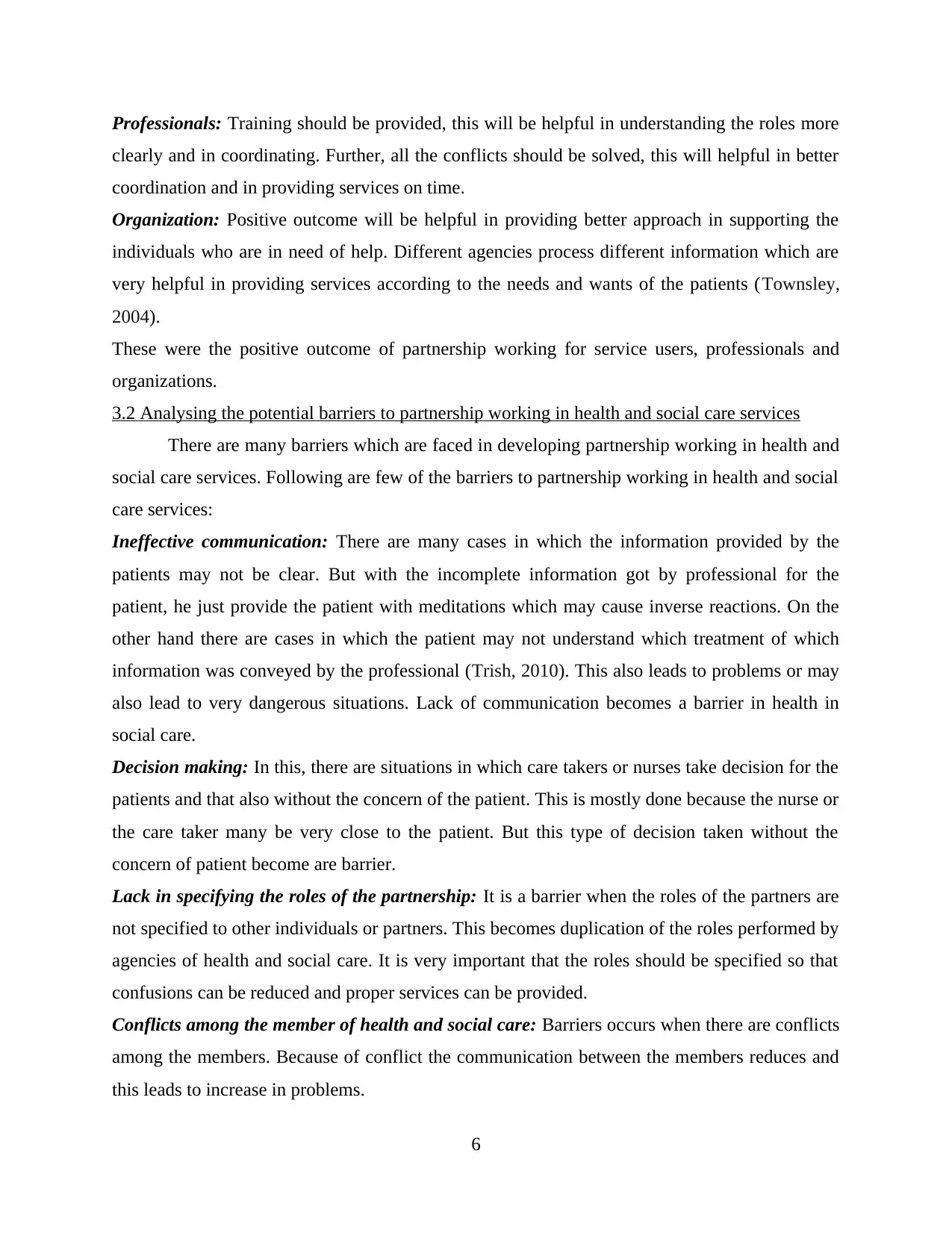
Professionals: Training should be provided, this will be helpful in understanding the roles more
clearly and in coordinating. Further, all the conflicts should be solved, this will helpful in better
coordination and in providing services on time.
Organization: Positive outcome will be helpful in providing better approach in supporting the
individuals who are in need of help. Different agencies process different information which are
very helpful in providing services according to the needs and wants of the patients (Townsley,
2004).
These were the positive outcome of partnership working for service users, professionals and
organizations.
3.2 Analysing the potential barriers to partnership working in health and social care services
There are many barriers which are faced in developing partnership working in health and
social care services. Following are few of the barriers to partnership working in health and social
care services:
Ineffective communication: There are many cases in which the information provided by the
patients may not be clear. But with the incomplete information got by professional for the
patient, he just provide the patient with meditations which may cause inverse reactions. On the
other hand there are cases in which the patient may not understand which treatment of which
information was conveyed by the professional (Trish, 2010). This also leads to problems or may
also lead to very dangerous situations. Lack of communication becomes a barrier in health in
social care.
Decision making: In this, there are situations in which care takers or nurses take decision for the
patients and that also without the concern of the patient. This is mostly done because the nurse or
the care taker many be very close to the patient. But this type of decision taken without the
concern of patient become are barrier.
Lack in specifying the roles of the partnership: It is a barrier when the roles of the partners are
not specified to other individuals or partners. This becomes duplication of the roles performed by
agencies of health and social care. It is very important that the roles should be specified so that
confusions can be reduced and proper services can be provided.
Conflicts among the member of health and social care: Barriers occurs when there are conflicts
among the members. Because of conflict the communication between the members reduces and
this leads to increase in problems.
6
clearly and in coordinating. Further, all the conflicts should be solved, this will helpful in better
coordination and in providing services on time.
Organization: Positive outcome will be helpful in providing better approach in supporting the
individuals who are in need of help. Different agencies process different information which are
very helpful in providing services according to the needs and wants of the patients (Townsley,
2004).
These were the positive outcome of partnership working for service users, professionals and
organizations.
3.2 Analysing the potential barriers to partnership working in health and social care services
There are many barriers which are faced in developing partnership working in health and
social care services. Following are few of the barriers to partnership working in health and social
care services:
Ineffective communication: There are many cases in which the information provided by the
patients may not be clear. But with the incomplete information got by professional for the
patient, he just provide the patient with meditations which may cause inverse reactions. On the
other hand there are cases in which the patient may not understand which treatment of which
information was conveyed by the professional (Trish, 2010). This also leads to problems or may
also lead to very dangerous situations. Lack of communication becomes a barrier in health in
social care.
Decision making: In this, there are situations in which care takers or nurses take decision for the
patients and that also without the concern of the patient. This is mostly done because the nurse or
the care taker many be very close to the patient. But this type of decision taken without the
concern of patient become are barrier.
Lack in specifying the roles of the partnership: It is a barrier when the roles of the partners are
not specified to other individuals or partners. This becomes duplication of the roles performed by
agencies of health and social care. It is very important that the roles should be specified so that
confusions can be reduced and proper services can be provided.
Conflicts among the member of health and social care: Barriers occurs when there are conflicts
among the members. Because of conflict the communication between the members reduces and
this leads to increase in problems.
6
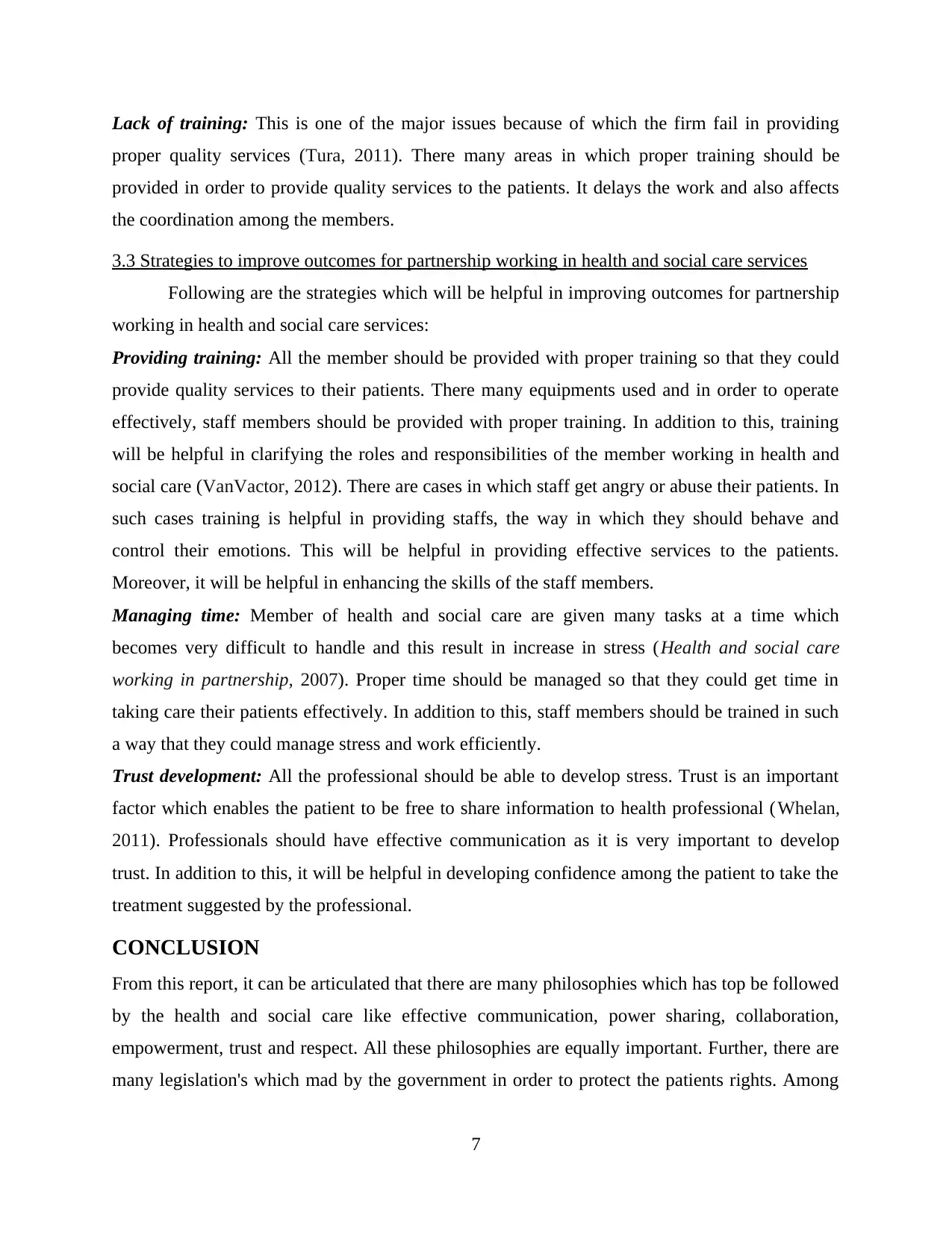
Lack of training: This is one of the major issues because of which the firm fail in providing
proper quality services (Tura, 2011). There many areas in which proper training should be
provided in order to provide quality services to the patients. It delays the work and also affects
the coordination among the members.
3.3 Strategies to improve outcomes for partnership working in health and social care services
Following are the strategies which will be helpful in improving outcomes for partnership
working in health and social care services:
Providing training: All the member should be provided with proper training so that they could
provide quality services to their patients. There many equipments used and in order to operate
effectively, staff members should be provided with proper training. In addition to this, training
will be helpful in clarifying the roles and responsibilities of the member working in health and
social care (VanVactor, 2012). There are cases in which staff get angry or abuse their patients. In
such cases training is helpful in providing staffs, the way in which they should behave and
control their emotions. This will be helpful in providing effective services to the patients.
Moreover, it will be helpful in enhancing the skills of the staff members.
Managing time: Member of health and social care are given many tasks at a time which
becomes very difficult to handle and this result in increase in stress (Health and social care
working in partnership, 2007). Proper time should be managed so that they could get time in
taking care their patients effectively. In addition to this, staff members should be trained in such
a way that they could manage stress and work efficiently.
Trust development: All the professional should be able to develop stress. Trust is an important
factor which enables the patient to be free to share information to health professional (Whelan,
2011). Professionals should have effective communication as it is very important to develop
trust. In addition to this, it will be helpful in developing confidence among the patient to take the
treatment suggested by the professional.
CONCLUSION
From this report, it can be articulated that there are many philosophies which has top be followed
by the health and social care like effective communication, power sharing, collaboration,
empowerment, trust and respect. All these philosophies are equally important. Further, there are
many legislation's which mad by the government in order to protect the patients rights. Among
7
proper quality services (Tura, 2011). There many areas in which proper training should be
provided in order to provide quality services to the patients. It delays the work and also affects
the coordination among the members.
3.3 Strategies to improve outcomes for partnership working in health and social care services
Following are the strategies which will be helpful in improving outcomes for partnership
working in health and social care services:
Providing training: All the member should be provided with proper training so that they could
provide quality services to their patients. There many equipments used and in order to operate
effectively, staff members should be provided with proper training. In addition to this, training
will be helpful in clarifying the roles and responsibilities of the member working in health and
social care (VanVactor, 2012). There are cases in which staff get angry or abuse their patients. In
such cases training is helpful in providing staffs, the way in which they should behave and
control their emotions. This will be helpful in providing effective services to the patients.
Moreover, it will be helpful in enhancing the skills of the staff members.
Managing time: Member of health and social care are given many tasks at a time which
becomes very difficult to handle and this result in increase in stress (Health and social care
working in partnership, 2007). Proper time should be managed so that they could get time in
taking care their patients effectively. In addition to this, staff members should be trained in such
a way that they could manage stress and work efficiently.
Trust development: All the professional should be able to develop stress. Trust is an important
factor which enables the patient to be free to share information to health professional (Whelan,
2011). Professionals should have effective communication as it is very important to develop
trust. In addition to this, it will be helpful in developing confidence among the patient to take the
treatment suggested by the professional.
CONCLUSION
From this report, it can be articulated that there are many philosophies which has top be followed
by the health and social care like effective communication, power sharing, collaboration,
empowerment, trust and respect. All these philosophies are equally important. Further, there are
many legislation's which mad by the government in order to protect the patients rights. Among
7
⊘ This is a preview!⊘
Do you want full access?
Subscribe today to unlock all pages.

Trusted by 1+ million students worldwide

which Data Protection Act 1998 states that all the information collected should be used only for
that purpose for which it has been collected and personal information should be destroyed after a
certain period. Further, there are many barriers in to partnership working in health and social
care services. Barriers like ineffective communication, decision making, lack in specifying the
roles of the partnership, conflicts among the member of health and social care, etc.
8
that purpose for which it has been collected and personal information should be destroyed after a
certain period. Further, there are many barriers in to partnership working in health and social
care services. Barriers like ineffective communication, decision making, lack in specifying the
roles of the partnership, conflicts among the member of health and social care, etc.
8
Paraphrase This Document
Need a fresh take? Get an instant paraphrase of this document with our AI Paraphraser
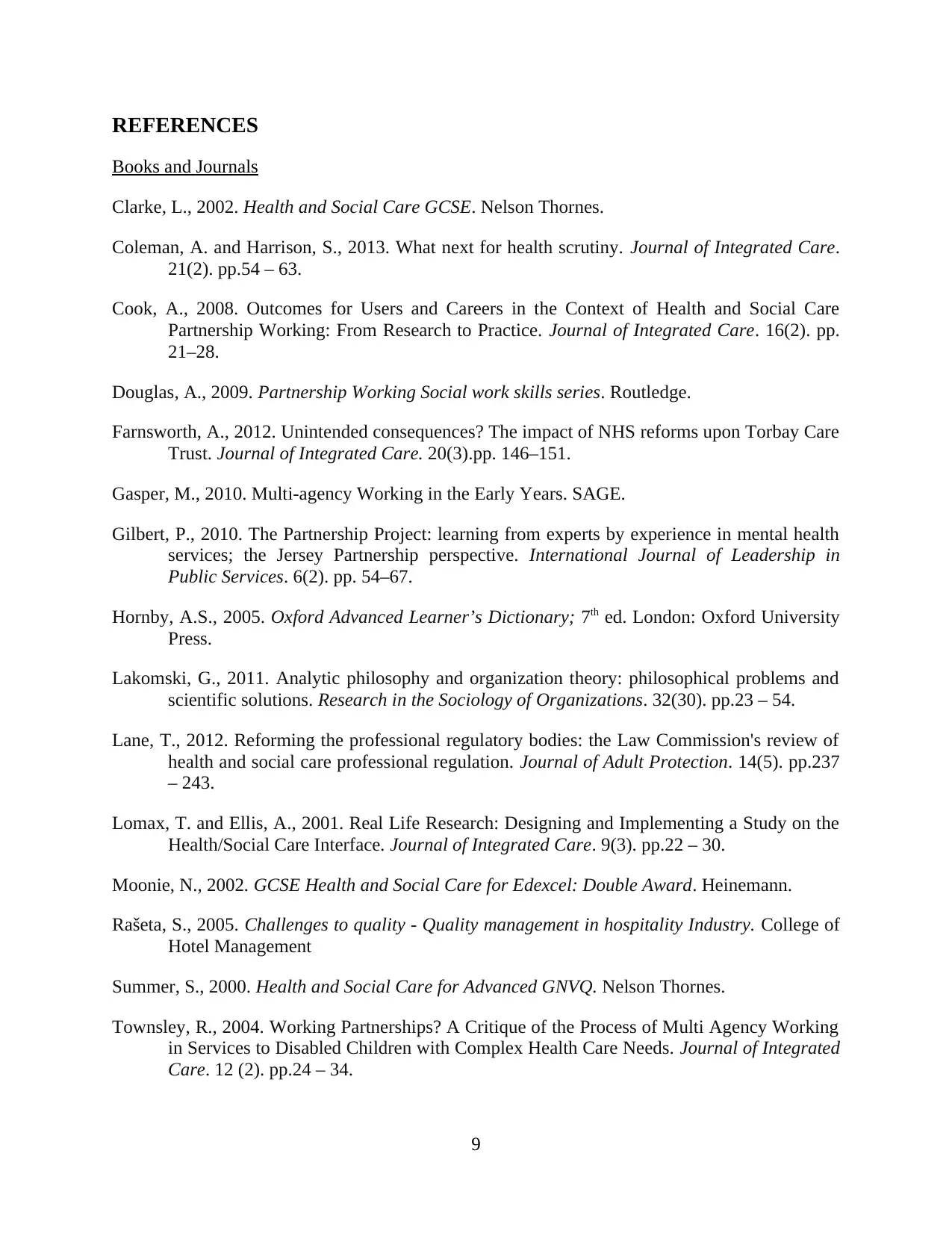
REFERENCES
Books and Journals
Clarke, L., 2002. Health and Social Care GCSE. Nelson Thornes.
Coleman, A. and Harrison, S., 2013. What next for health scrutiny. Journal of Integrated Care.
21(2). pp.54 – 63.
Cook, A., 2008. Outcomes for Users and Careers in the Context of Health and Social Care
Partnership Working: From Research to Practice. Journal of Integrated Care. 16(2). pp.
21–28.
Douglas, A., 2009. Partnership Working Social work skills series. Routledge.
Farnsworth, A., 2012. Unintended consequences? The impact of NHS reforms upon Torbay Care
Trust. Journal of Integrated Care. 20(3).pp. 146–151.
Gasper, M., 2010. Multi-agency Working in the Early Years. SAGE.
Gilbert, P., 2010. The Partnership Project: learning from experts by experience in mental health
services; the Jersey Partnership perspective. International Journal of Leadership in
Public Services. 6(2). pp. 54–67.
Hornby, A.S., 2005. Oxford Advanced Learner’s Dictionary; 7th ed. London: Oxford University
Press.
Lakomski, G., 2011. Analytic philosophy and organization theory: philosophical problems and
scientific solutions. Research in the Sociology of Organizations. 32(30). pp.23 – 54.
Lane, T., 2012. Reforming the professional regulatory bodies: the Law Commission's review of
health and social care professional regulation. Journal of Adult Protection. 14(5). pp.237
– 243.
Lomax, T. and Ellis, A., 2001. Real Life Research: Designing and Implementing a Study on the
Health/Social Care Interface. Journal of Integrated Care. 9(3). pp.22 – 30.
Moonie, N., 2002. GCSE Health and Social Care for Edexcel: Double Award. Heinemann.
Rašeta, S., 2005. Challenges to quality - Quality management in hospitality Industry. College of
Hotel Management
Summer, S., 2000. Health and Social Care for Advanced GNVQ. Nelson Thornes.
Townsley, R., 2004. Working Partnerships? A Critique of the Process of Multi Agency Working
in Services to Disabled Children with Complex Health Care Needs. Journal of Integrated
Care. 12 (2). pp.24 – 34.
9
Books and Journals
Clarke, L., 2002. Health and Social Care GCSE. Nelson Thornes.
Coleman, A. and Harrison, S., 2013. What next for health scrutiny. Journal of Integrated Care.
21(2). pp.54 – 63.
Cook, A., 2008. Outcomes for Users and Careers in the Context of Health and Social Care
Partnership Working: From Research to Practice. Journal of Integrated Care. 16(2). pp.
21–28.
Douglas, A., 2009. Partnership Working Social work skills series. Routledge.
Farnsworth, A., 2012. Unintended consequences? The impact of NHS reforms upon Torbay Care
Trust. Journal of Integrated Care. 20(3).pp. 146–151.
Gasper, M., 2010. Multi-agency Working in the Early Years. SAGE.
Gilbert, P., 2010. The Partnership Project: learning from experts by experience in mental health
services; the Jersey Partnership perspective. International Journal of Leadership in
Public Services. 6(2). pp. 54–67.
Hornby, A.S., 2005. Oxford Advanced Learner’s Dictionary; 7th ed. London: Oxford University
Press.
Lakomski, G., 2011. Analytic philosophy and organization theory: philosophical problems and
scientific solutions. Research in the Sociology of Organizations. 32(30). pp.23 – 54.
Lane, T., 2012. Reforming the professional regulatory bodies: the Law Commission's review of
health and social care professional regulation. Journal of Adult Protection. 14(5). pp.237
– 243.
Lomax, T. and Ellis, A., 2001. Real Life Research: Designing and Implementing a Study on the
Health/Social Care Interface. Journal of Integrated Care. 9(3). pp.22 – 30.
Moonie, N., 2002. GCSE Health and Social Care for Edexcel: Double Award. Heinemann.
Rašeta, S., 2005. Challenges to quality - Quality management in hospitality Industry. College of
Hotel Management
Summer, S., 2000. Health and Social Care for Advanced GNVQ. Nelson Thornes.
Townsley, R., 2004. Working Partnerships? A Critique of the Process of Multi Agency Working
in Services to Disabled Children with Complex Health Care Needs. Journal of Integrated
Care. 12 (2). pp.24 – 34.
9
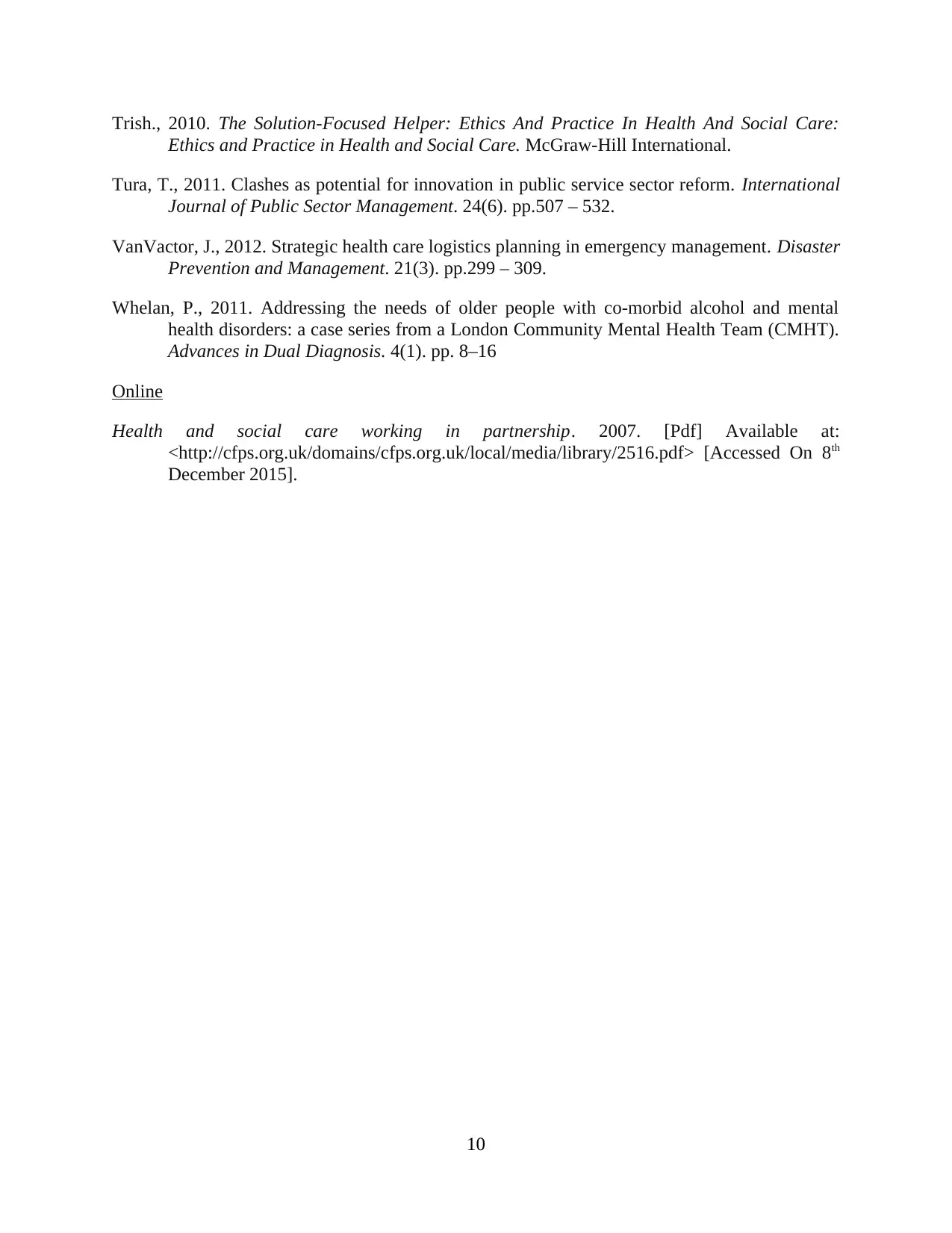
Trish., 2010. The Solution-Focused Helper: Ethics And Practice In Health And Social Care:
Ethics and Practice in Health and Social Care. McGraw-Hill International.
Tura, T., 2011. Clashes as potential for innovation in public service sector reform. International
Journal of Public Sector Management. 24(6). pp.507 – 532.
VanVactor, J., 2012. Strategic health care logistics planning in emergency management. Disaster
Prevention and Management. 21(3). pp.299 – 309.
Whelan, P., 2011. Addressing the needs of older people with co-morbid alcohol and mental
health disorders: a case series from a London Community Mental Health Team (CMHT).
Advances in Dual Diagnosis. 4(1). pp. 8–16
Online
Health and social care working in partnership. 2007. [Pdf] Available at:
<http://cfps.org.uk/domains/cfps.org.uk/local/media/library/2516.pdf> [Accessed On 8th
December 2015].
10
Ethics and Practice in Health and Social Care. McGraw-Hill International.
Tura, T., 2011. Clashes as potential for innovation in public service sector reform. International
Journal of Public Sector Management. 24(6). pp.507 – 532.
VanVactor, J., 2012. Strategic health care logistics planning in emergency management. Disaster
Prevention and Management. 21(3). pp.299 – 309.
Whelan, P., 2011. Addressing the needs of older people with co-morbid alcohol and mental
health disorders: a case series from a London Community Mental Health Team (CMHT).
Advances in Dual Diagnosis. 4(1). pp. 8–16
Online
Health and social care working in partnership. 2007. [Pdf] Available at:
<http://cfps.org.uk/domains/cfps.org.uk/local/media/library/2516.pdf> [Accessed On 8th
December 2015].
10
⊘ This is a preview!⊘
Do you want full access?
Subscribe today to unlock all pages.

Trusted by 1+ million students worldwide
1 out of 12
Related Documents
Your All-in-One AI-Powered Toolkit for Academic Success.
+13062052269
info@desklib.com
Available 24*7 on WhatsApp / Email
![[object Object]](/_next/static/media/star-bottom.7253800d.svg)
Unlock your academic potential
Copyright © 2020–2025 A2Z Services. All Rights Reserved. Developed and managed by ZUCOL.





